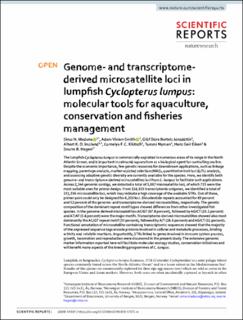| dc.description.abstract | The lumpfish Cyclopterus lumpus is commercially exploited in numerous areas of its range in the North Atlantic Ocean, and is important in salmonid aquaculture as a biological agent for controlling sea lice. Despite the economic importance, few genetic resources for downstream applications, such as linkage mapping, parentage analysis, marker-assisted selection (MAS), quantitative trait loci (QTL) analysis, and assessing adaptive genetic diversity are currently available for the species. Here, we identify both genome- and transcriptome-derived microsatellites loci from C. lumpus to facilitate such applications. Across 2,346 genomic contigs, we detected a total of 3,067 microsatellite loci, of which 723 were the most suitable ones for primer design. From 116,555 transcriptomic unigenes, we identified a total of 231,556 microsatellite loci, which may indicate a high coverage of the available STRs. Out of these, primer pairs could only be designed for 6,203 loci. Dinucleotide repeats accounted for 89 percent and 52 percent of the genome- and transcriptome-derived microsatellites, respectively. The genetic composition of the dominant repeat motif types showed differences from other investigated fish species. In the genome-derived microsatellites AC/GT (67.8 percent), followed by AG/CT (15.1 percent) and AT/AT (5.6 percent) were the major motifs. Transcriptome-derived microsatellites showed also most dominantly the AC/GT repeat motif (33 percent), followed by A/T (26.6 percent) and AG/CT (11 percent). Functional annotation of microsatellite-containing transcriptomic sequences showed that the majority of the expressed sequence tags encode proteins involved in cellular and metabolic processes, binding activity and catalytic reactions. Importantly, STRs linked to genes involved in immune system process, growth, locomotion and reproduction were discovered in the present study. The extensive genomic marker information reported here will facilitate molecular ecology studies, conservation initiatives and will benefit many aspects of the breeding programmes of C. lumpus. | en_US |

